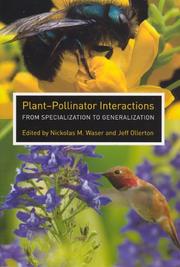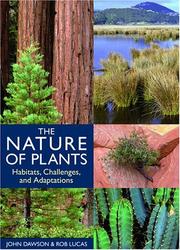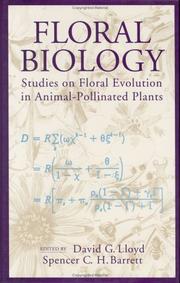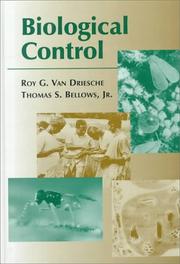| Listing 1 - 8 of 8 |
Sort by
|

ISBN: 0226874001 Year: 2006 Publisher: Chicago (Ill.) : University of Chicago press,
Abstract | Keywords | Export | Availability | Bookmark
 Loading...
Loading...Choose an application
- Reference Manager
- EndNote
- RefWorks (Direct export to RefWorks)
Just as flowering plants depend on their pollinators, many birds, insects, and bats rely on plants for energy and nutrients. This plant-pollinator relationship is essential to the survival of natural and agricultural ecosystems. 'Plant-Pollinator Interactions' portrays the intimate relationships of pollination over time and space and reveals patterns of interactions from individual to community levels, showing how these patterns change at different spatial and temporal scales. Nickolas M. Waser and Jeff Ollerton bring together experts from around the world to offer a comprehensive analysis of pollination, including the history of thinking about specialization and generalization and a comparison of pollination to other mutualisms. An overview of current thinking and of future research priorities, 'Plant-Pollinator Interactions 'covers an important theme in evolutionary ecology with far-reaching applications in conservation and agriculture. This book will find an eager audience in specialists studying pollination and other mutualisms, as well as with biologists who are interested in ecological, evolutionary, and behavioral aspects of the specialization and generalization of species.
Book
ISBN: 3782910958 Year: 1985 Publisher: Frankfurt am Main Verlag von Waldemar Kramer
Abstract | Keywords | Export | Availability | Bookmark
 Loading...
Loading...Choose an application
- Reference Manager
- EndNote
- RefWorks (Direct export to RefWorks)
bats --- chiropterophily --- pollination by animals --- reproductive biology --- zoophilous
Book
ISSN: 21102228 ISBN: 9782759228003 2759228002 Year: 2018 Publisher: Paris: Quæ,
Abstract | Keywords | Export | Availability | Bookmark
 Loading...
Loading...Choose an application
- Reference Manager
- EndNote
- RefWorks (Direct export to RefWorks)
Pollination by animals --- Pollination --- Pollinisation par les animaux --- Pollinisation --- Plantes --- Fécondation par les insectes --- Pollinisation par les animaux. --- Pollinisation. --- Fécondation par les insectes. --- Fécondation par les insectes.
Book
ISBN: 9780521198929 9781139204439 1139204432 0521198925 9781139206013 113920601X 9781139014113 1139014110 1139203029 9781139203029 9781280484285 1280484284 1139199412 1107223822 6613579262 1139205218 9786613579263 1139201611 Year: 2012 Volume: 81 Publisher: Cambridge Cambridge University Press
Abstract | Keywords | Export | Availability | Bookmark
 Loading...
Loading...Choose an application
- Reference Manager
- EndNote
- RefWorks (Direct export to RefWorks)
What are the evolutionary mechanisms and ecological implications behind a pollinator choosing its favourite flower? Sixty-five million years of evolution has created the complex and integrated system which we see today and understanding the interactions involved is key to environmental sustainability. Examining pollination relationships from an evolutionary perspective, this book covers both botanical and zoological aspects. It addresses the puzzling question of co-speciation and co-evolution and the complexity of the relationships between plant and pollinator, the development of which is examined through the fossil record. Additional chapters are dedicated to the evolution of floral displays and signalling, as well as their role in pollination syndromes and the building of pollination networks. Wide-ranging in its coverage, it outlines current knowledge and complex emerging topics, demonstrating how advances in research methods are applied to pollination biology.
Pollination by insects --- Pollination by animals --- Plants --- Pollinators --- Evolution --- Plant-pollinator relationships. --- Pollenizers --- Pollinating organisms --- Pollinating species --- Pollinator organisms --- Pollinator species --- Pollinizers --- Biology --- Plant evolution --- Evolution (Biology) --- Plant-pollinator interactions --- Plants and pollinators --- Pollinator-plant interactions --- Pollinator-plant relationships --- Pollinators and plants --- Animal-plant relationships --- Evolution. --- Phylogeny --- Pollination by insects. --- Pollination by animals. --- Insect pollination --- Fertilization of plants by insects --- Plants - Evolution --- Pollinators - Evolution

ISBN: 0881926752 Year: 2005 Publisher: Portland Cambridge : Timber Press,
Abstract | Keywords | Export | Availability | Bookmark
 Loading...
Loading...Choose an application
- Reference Manager
- EndNote
- RefWorks (Direct export to RefWorks)
ECO Ecology --- plant ecology --- adaptation and evolution --- environment and adaptation --- adaptative strategies --- habitat ecology --- habitats --- plant communities --- plants and animals --- pollination by animals --- bacteria --- Fungi --- Botany --- Plant communities --- Plant ecology --- Plants

ISBN: 0412043416 1461284945 1461311659 9780412043413 Year: 1996 Publisher: New York, N.Y. Chapman & Hall
Abstract | Keywords | Export | Availability | Bookmark
 Loading...
Loading...Choose an application
- Reference Manager
- EndNote
- RefWorks (Direct export to RefWorks)
Pollination by insects --- Pollination by animals --- Angiosperms --- -Flowers --- Evolution --- Magnoliophyta --- Fleur --- Flowers --- Morphogénèse --- Morphogenesis --- Morphologie végétale --- Plant morphology --- Pollinisation --- Pollination --- Pollinisateur --- Pollinators --- Réponse de la plante --- Plant response --- Flowers. --- Pollination by animals. --- Pollination by insects. --- Evolution. --- REP Reproductive Biology --- animal-plant relationships --- floral biology --- pollination by animals --- pollination by insects --- reproductive biology --- 581.46 --- 581.145.1 --- 581.162.3 --- 575.854 --- #WPLT:syst --- Insect pollination --- Fertilization of plants by insects --- Animal-plant relationships --- Blooms (Flowers) --- Blossoms --- Flowering plants --- Inflorescences --- Plants --- Floral products --- Phanerogams --- Tissue, organs and function --- 575.854 Tissue, organs and function --- 581.162.3 Pollination --- 581.145.1 Flowers --- 581.46 Flowers --- Angiosperms - - Evolution --- Plant genetics. Plant evolution --- Plant ecology. Plant sociology

ISBN: 0412028611 1461284902 1461311578 9780412028618 Year: 1996 Publisher: New York ; Paris ; Singapore Chapman & Hall
Abstract | Keywords | Export | Availability | Bookmark
 Loading...
Loading...Choose an application
- Reference Manager
- EndNote
- RefWorks (Direct export to RefWorks)
Animal pollinizers --- Animaux [Pollinisation par les ] --- Animaux pollinisateurs --- Bestuiving door dieren --- Bestuiving door insekten --- Dieren [Bestuivende ] --- Dieren [Bestuiving door ] --- Insect pollenizers --- Insectes pollinisateurs --- Insekten [Bestuivende ] --- Pollination by animals --- Pollination by insects --- Pollinisation par les animaux --- Pollinisation par les insectes --- Pests --- Biological control. --- Plant and Crop Sciences Plant and Crop Protection -- Biological Control --- ALLW. --- Biological control --- Angiosperms --- Evolution --- Pests - Biological control
Book
ISBN: 9780691128610 0691128618 9786613310408 1283310406 1400838940 9781400838943 9781283310406 6613310409 Year: 2011 Publisher: Princeton, NJ
Abstract | Keywords | Export | Availability | Bookmark
 Loading...
Loading...Choose an application
- Reference Manager
- EndNote
- RefWorks (Direct export to RefWorks)
Pollination and Floral Ecology is the most comprehensive single-volume reference to all aspects of pollination biology--and the first fully up-to-date resource of its kind to appear in decades. This beautifully illustrated book describes how flowers use colors, shapes, and scents to advertise themselves; how they offer pollen and nectar as rewards; and how they share complex interactions with beetles, birds, bats, bees, and other creatures. The ecology of these interactions is covered in depth, including the timing and patterning of flowering, competition among flowering plants to attract certain visitors and deter others, and the many ways plants and animals can cheat each other. Pollination and Floral Ecology pays special attention to the prevalence of specialization and generalization in animal-flower interactions, and examines how a lack of distinction between casual visitors and true pollinators can produce misleading conclusions about flower evolution and animal-flower mutualism. This one-of-a-kind reference also gives insights into the vital pollination services that animals provide to crops and native flora, and sets these issues in the context of today's global pollination crisis. Provides the most up-to-date resource on pollination and floral ecology Describes flower advertising features and rewards, foraging and learning by flower-visiting animals, behaviors of generalist and specialist pollinators--and more Examines the ecology and evolution of animal-flower interactions, from the molecular to macroevolutionary scale Features hundreds of color and black-and-white illustrations
Pollination --- Pollination by insects --- Pollination by animals --- Plant ecology --- Pollinisation --- Pollination. --- Pollination by insects. --- Pollination by animals. --- Plant ecology. --- Pollinisation par les insectes --- Pollinisation par les animaux --- Ecologie végétale --- Insect pollination --- Pollinization --- Botany --- Plants --- Ecology --- Animal-plant relationships --- Fertilization of plants by insects --- Fertilization of plants --- Flowers --- Phanerogams --- Pollen --- Self-incompatibility --- Pollinisation. --- Phytoecology --- Vegetation ecology --- Floristic ecology --- Diptera. --- Lepidoptera. --- Megachiroptera. --- Microchiroptera. --- abiotic pollination. --- advertisement. --- amphibian. --- anemophilous plant. --- anemophily. --- angiosperm. --- animal pollination. --- animal. --- animals. --- animalЦlower interaction. --- ant. --- bat pollination. --- bats. --- bee pollination. --- bee. --- bees. --- beetle. --- behavior. --- bird pollination. --- birds. --- bumblebee. --- butterfly. --- carrion fly. --- chiropterophily. --- color vision. --- conifer. --- cost. --- cross-fertilization. --- cross-pollination. --- diversification. --- ectotherm vertebrate. --- feeding apparatus. --- fish. --- floral color. --- floral constancy. --- floral design. --- floral display. --- floral divergence. --- floral odor. --- floral pigment. --- floral scent. --- floral sex. --- floral shape. --- floral signal. --- floral size. --- floral tissue. --- floral variation. --- flower evolution. --- flower morphology. --- flower pollination. --- flower visitor. --- flower. --- flowering. --- flowers. --- flowerаollinator interaction. --- fly pollination. --- foraging behavior. --- generalist flower. --- generalist visitor. --- grasshopper. --- hawkmoth. --- honeybee. --- hoverfly. --- hummingbird. --- hydrophily. --- inflorescence. --- insect. --- invertebrate. --- learning. --- marsupial. --- melittophily. --- monkey. --- mutualism. --- nectar biology. --- nectar concentration. --- nectar gathering. --- nectar guide. --- nectar production. --- nectar secretion. --- nectar volume. --- nectar. --- nectary. --- nonflying mammal. --- nonflying vertebrate. --- odor learning. --- oil. --- olfaction. --- olfactory signal. --- ornithophily. --- perching bird. --- phalaenophily. --- plant diversity. --- plant fertilization. --- plant mating. --- plant pollination. --- plant reproduction. --- plant sex. --- plant speciation. --- plant. --- plants. --- pollen biology. --- pollen competition. --- pollen eating. --- pollen gathering. --- pollen packaging. --- pollen. --- pollination biology. --- pollination ecology. --- pollination syndromes. --- pollination. --- pollinator effectiveness. --- pollinator. --- psychophily. --- reproductive isolation. --- resin. --- reward. --- scent. --- selection. --- self-fertilization. --- selfing. --- sexual function. --- sociality. --- specialist flower. --- specialization. --- speciation. --- sphingophily. --- stigmatic exudate. --- thrip. --- visitation pattern. --- visual signal. --- wasp. --- wax. --- wind pollination.
| Listing 1 - 8 of 8 |
Sort by
|

 Search
Search Feedback
Feedback About UniCat
About UniCat  Help
Help News
News